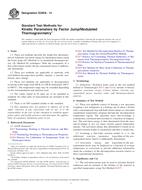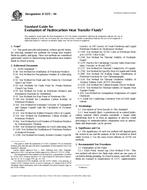1.1 This practice covers a general procedure for using the Process Compensated Resonance Testing (PCRT) via swept sine input method to perform Part-to-Itself (PTI) examination on populations of newly manufactured and in-service parts. PCRT detects resonance pattern differences in metallic and non-metallic parts. Practice E2534 for Defect Detection with PCRT and Practice E3081 for Outlier Screening with PCRT cover the development and application of PCRT sorting modules that inspect a part at a single point in time. These methods use the resonance frequency spectra recorded from test parts and perform different statistical analyses to compare test parts to reference populations. These comparisons include, and must compensate for, the normal geometric, material, and processing variations present in any population of parts. In many applications, however, the user may need to evaluate the effects of a single processing step or in-service load in isolation from other sources of variation. For example, a manufacturer may want to perform process monitoring and control on a heat treatment or hardening process. A maintainer may want to evaluate the effect of service cycles in an engine. A PCRT PTI examination measures the resonance frequency spectrum of a part at two points in time, such as before and after a manufacturing process step, and calculates the change in resonance frequencies to evaluate the effect of the intervening process. Control limits can be set on the frequency change to field a PTI PASS/FAIL inspection capability. The limits may be based on training populations of parts with acceptable and unacceptable levels of change, model predictions of the effects of part changes, or criteria derived from process control practices. Manufacturing processes and in-service loads that can be evaluated with a PCRT PTI inspection include, but are not limited to heat treatment, hot isostatic pressing (HIP), shot peening, induction hardening, carburization, coating, thermal history changes, residual stress changes, creep, plastic deformation, corrosion, and fatigue. This practice is intended for use with instruments capable of exciting, measuring, recording, and analyzing multiple, whole body, mechanical vibration resonance frequencies in acoustic or ultrasonic frequency ranges, or both.
Product Details
- Published:
- 05/01/2019
- Number of Pages:
- 9
- File Size:
- 1 file , 330 KB


